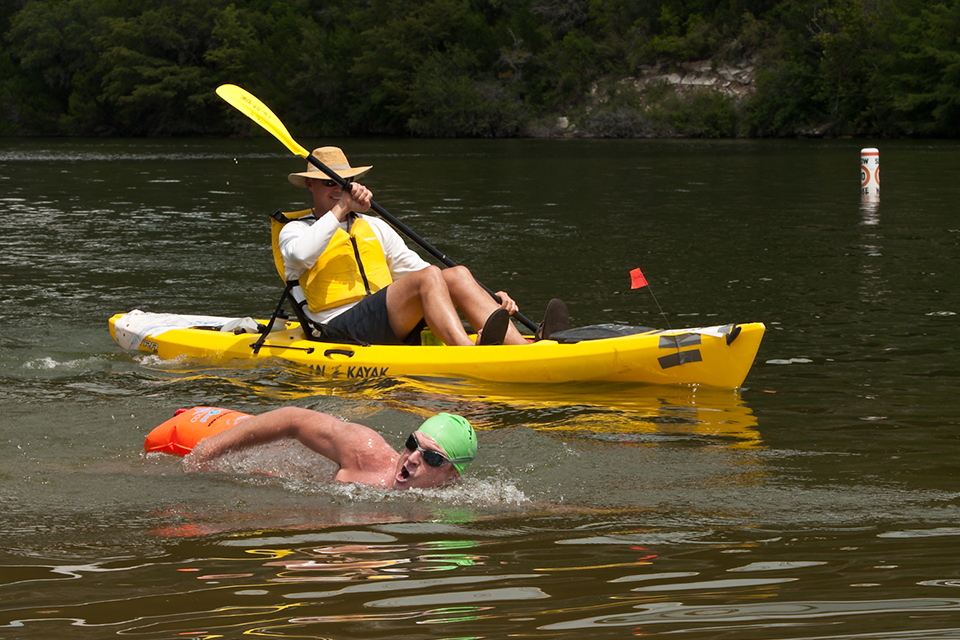What's in the Water Part III: The Dangers of Other People

Boaters, fishermen, other swimmers, and a swimmer’s own issues can cause distress in open water.
Boaters and Fishermen
In local lakes that permit motorized boats, swimmers must ensure that they don’t get run over. Since Texas does not require boating classes (and since alcohol or inexperience can cause erratic behavior), swimmers need to look out for themselves. Even the best boat driver may be unable to see a swimmer, so the swimmer needs to splash, make noise, and swim a safe distance away as quickly as possible.
In these types of situations, it’s best to swim in a group surrounded by safety kayakers and use brightly colored swim caps and swim buoys that buckle around the waist and float behind. For example, swimmers for Colin’s Hope, an Austin charity devoted to preventing childhood drowning, must use an orange safety buoy during swims and must have a personal safety kayaker alongside them at all times.
Fortunately, fishermen don’t normally cast their lines on top of swimmers, but they sometimes set trotlines that swimmers might bump into if they’re not careful. It’s also important for swimmers to be wary of abandoned fishhooks, tools, and fishing line at locations frequented by fishermen.
Other Swimmers
In a triathlon, the start of a race sometimes looks like a fight. Swimmers hit, grab, and even swim over each other. While most of these actions are unintentional, they can feel deliberate. Coach Jennifer Reinhart with Tri Zones Training recommends that triathletes who are new to the sport or are nervous about the mass swim start position themselves either toward the back of the pack or to the extreme left or right side. What a swimmer may lose in speed, they gain in safety.
Some local triathlons now use a time trial swim start, in which one swimmer is allowed to enter the water every few seconds. This plan encourages swimmer safety and reduces crowding and panic.
A Swimmer’s Own Issues
In open water, swimmers can be their own worst enemy. Panicking in the water can turn a slightly dangerous situation into a deadly one. Whether you see a snake, get caught in hydrilla, or encounter another similar scary situation, it’s important to stay calm. Chances are nothing bad will happen to a calm, clear-headed swimmer.
For beginning open water swimmers, it’s best to start off in a controlled environment like Barton Springs Pool to build some confidence. Although the water is cold—making breathing difficult for some swimmers—Barton Springs is shallow at one end and smaller than true open water venues.
It’s a good idea for everyone to practice in cold water to learn how lung constriction may feel since the breathing muscles can tighten both in cold water and in a panic situation. “When we’re in the water and we feel in trouble, we often stroke faster,” Cindy Burton of Training with Coach Cindy said. “Stroking faster makes us need more oxygen and leads us to that next breath quicker. So, even though it feels counter intuitive, try to slow down your stroke and breathe deeper. Remember: breathe slow and deep versus fast and shallow.”
Your first triathlon swim may be the scariest situation of all. Better to swim slow and calm than to panic and possibly not even finish the swim. “Even in a triathlon, it’s okay to stop, hang out, and hold onto a boat. As long as you don’t make forward progress, there is no penalty,” Burton said. “So, if you get out of breath, take a break. Let yourself completely catch your breath before you try to make forward progress again.”
Learn to be calm and confident in open water so you don’t become your own worst enemy. And most importantly: get enough open water swim practice so that you feel confident in your swimming ability on race day.






